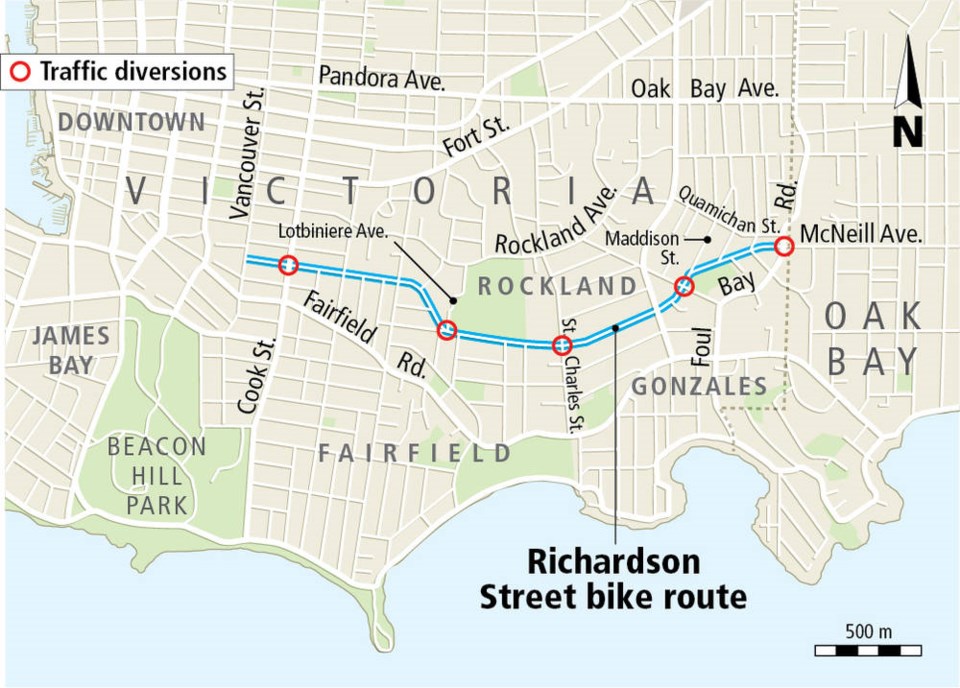A commentary by a member of Cities for Everyone, a local organization that advocates for more affordable and inclusive communities.
Like many families, we recently got a pandemic puppy. We frequently walk and bike-trailer her on local streets, including Victoria’s bikeway network. What we see is good news for people and dogs who want a more livable city, and bad news for bikeway critics.
Victoria’s protected bike lanes let us ride safely and comfortably on busy roads such as Pandora Avenue and Fort Street.
Vancouver Street’s new bikeway provides a very pleasant environment for active travellers — walkers, cyclists and puppies. Richardson Street, the next bikeway link, will soon offer another fine route for non-motorized travel.
These positive experiences contrast with the fear-mongering of people who argue that Victoria’s bikeway network is wasteful and unfair. My report Evaluating Bikeway Criticism (https://bit.ly/3ult1sZ) examines their claims.
Here are key findings:
Victoria already has high rates of walking and bicycling, and we have targets to double their use in order to help achieve our affordability, health and environmental goals. Everybody benefits if we succeed.
A significant portion of trips are by walking and bicycling. Our city has targets to approximately double their use.
To help achieve these targets, Victoria is building an All Ages and Abilities (AAA) bikeway network where active modes have priority over automobile traffic.
Most people I know support this plan, but there are vocal critics, including out-of-town motorists who complain that bikeways impair their driving. Their objections tend to be inaccurate, exaggerated and selfish.
Critics ignore the high costs that automobile traffic imposes on communities. Motorists often say things such as: “I just want to drive through Victoria like I used to” or “don’t slow me down, I’m a better-than-average driver.”
They assume that their driving is harmless, but even a perfect driver operating an electric car causes significant risk and disruption when driving through urban neighbourhoods.
Due to their large size, speed and risk, motor vehicles impose more than 10 times as much infrastructure, crash and environmental costs as active modes.
Do you want to avoid these impacts? There are two ways to do this.
You can move to an isolated suburban area, but residents there must spend a lot of money and time driving, and impose traffic problems on other streets.
Alternatively, you can choose a home in a walkable and bikeable urban neighbourhood where you can minimize car trips. This reduces your transportation costs and the traffic impacts you impose on others.
Our community becomes healthier, wealthier and happier when we reach for bike helmets instead of car keys for local trips. Our AAA bikeway network helps make this happen.
Critics exaggerate delays to motorists and ignore most bikeway benefits.
For example, a recent letter to the editor claimed that Richardson Street’s bikeway will add five to seven minutes to Oak Bay to downtown Victoria car trips, but according to Google Maps, Oak Bay Avenue is shorter and faster (4.8 km, 12 minutes) than Richardson Street (5.1 km, 13 minutes) for Oak Bay to downtown trips.
It is absurd to claim that Richardson’s bikeway will delay numerous car trips because it is already the slower route.
On the other hand, by improving active travel safety and comfort, this bikeway will increase walking and bicycling and reduce traffic problems, which benefits everybody.
For example, bikeways reduce the need for motorists to chauffeur non-drivers, saving drivers’ time and money, and reducing traffic problems.
Extensive experience indicates that residents in walkable and bikeable neighbourhoods are much safer, healthier and happier, and save money. An honest appraisal considers all of these impacts, not just motorists’ delays.
Critics are wrong and selfish to claim that Victoria’s bikeway investments are excessive. Motorists get more than their fair share of the roadway pie: more than 90 per cent of Victoria’s road space and transportation spending is devoted to motor vehicles, while less than three per cent of street space, seven per cent of roadway spending and two per cent of total road and parking facility expenditure is devoted to bikeways.
This is far less than the portion of residents who bicycle and our mode share targets. Overall, bicyclists subsidize motorists, and Victoria residents subsidize out-of-town car trips. That is unfair.
It is particularly rude for suburban motorists to complain when Victoria tames traffic on our neighbourhood streets. We welcome visitors, but please come by active or public transport when possible, and if you must drive, observe our traffic rules without complaint.
Let me offer critics sympathy and advice.
Yes, change is difficult. Motorists who assume that their needs are paramount are understandably frustrated by street design changes favouring slower modes. It’s as if the rules of a race changed to favour slower competitors.
But these changes benefit most people overall, including motorists who gain from less congestion and reduced chauffeuring burdens. My advice: Give bikeways a chance.



